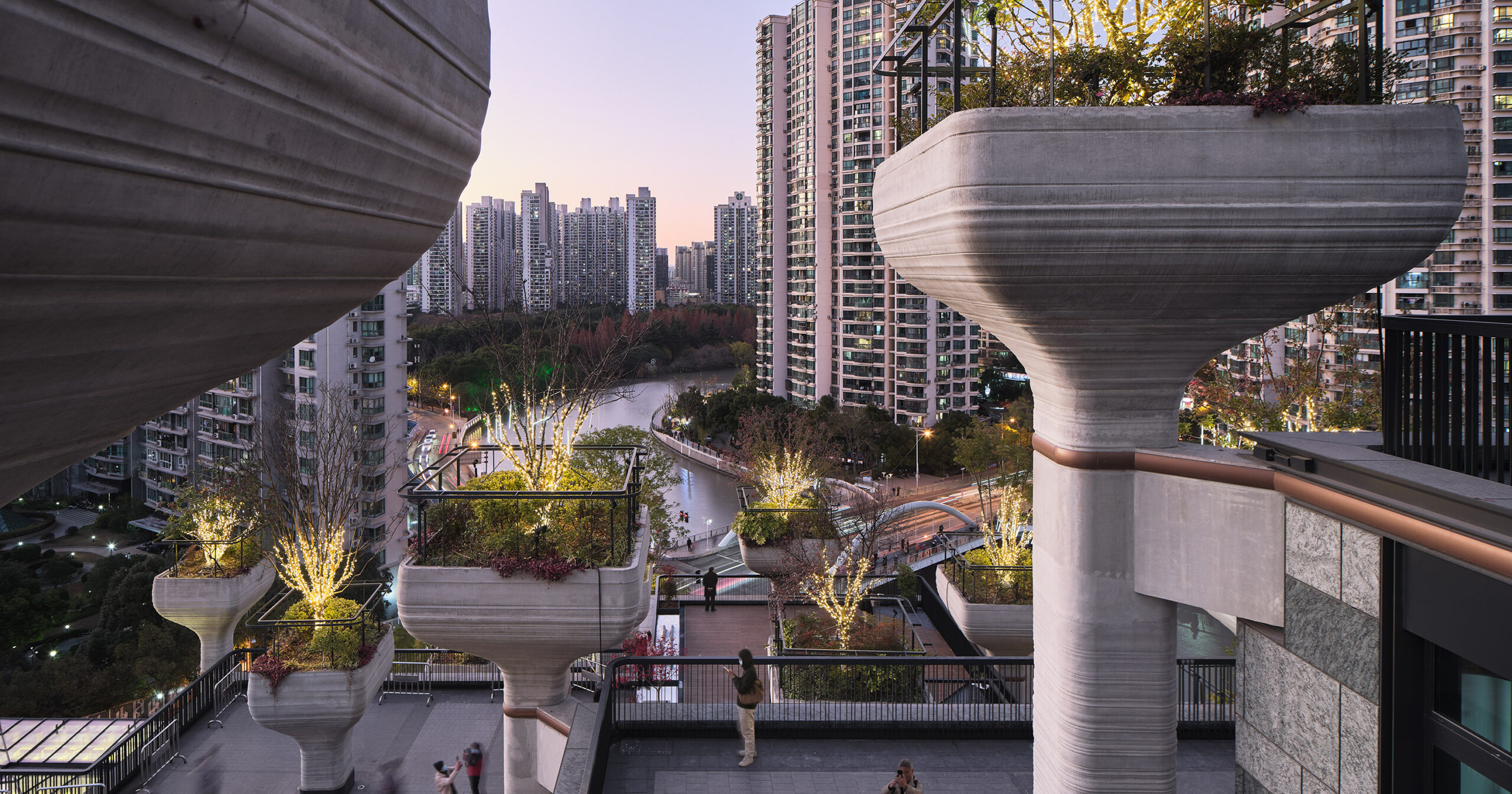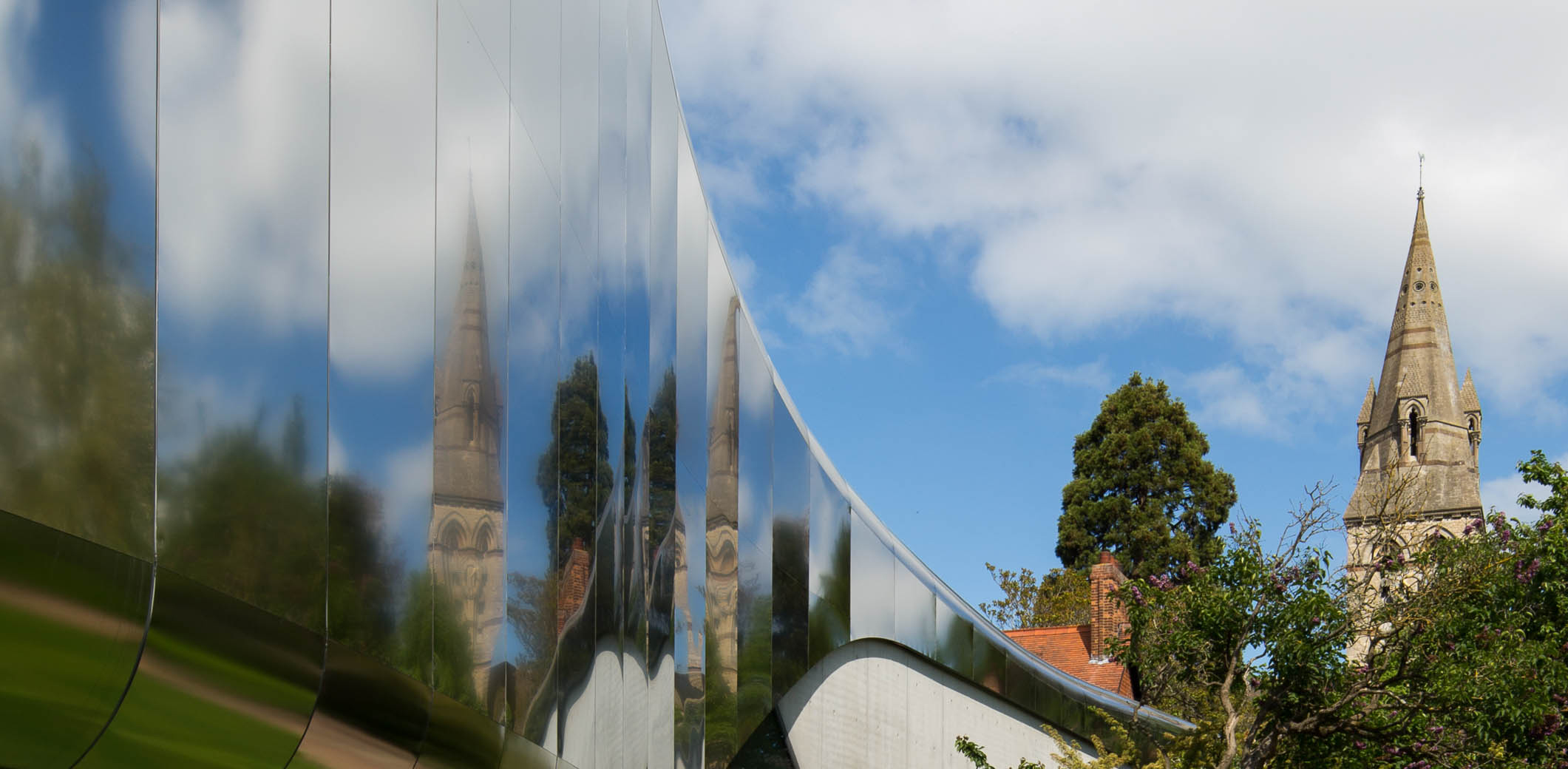The judging process for Architizer's 12th Annual A+Awards is now away. Subscribe to our Awards Newsletter to receive updates about Public Voting, and stay tuned for winners announcements later this spring.
Shanghai’s most architecturally unique shopping destination comprises 12 flagship stores, 91 shops and 63 food and beverage outlets across 678,126 square feet (63,000 square meters) of mixed-use space. It is an enormous development featuring promenades and public realms, with a southern façade doubling up as a giant street art gallery.
In many ways, all this is almost beside the point. Walking away with both Jury Winner and Popular Choice Winner accolades in the Shopping Centre category at Architizer’s 11th Annual A+Awards, Phase 1 of the 1000 Trees project excels because it was designed to make a huge impression in a series of comparatively small, human-scale parts.
Built at a 45-degree angle to the river, the building lines, a series of pillars at varying heights, delineate sections and visually break the structure up. But these partitions also serve another crucial purpose. Planters top each column and collectively offer a home to 1,000 deciduous and evergreen trees, along with 250,000 hanging plants and shrubs. The result is significant biodiversity net gain from the project, creating a place for nature to survive — and hopefully thrive — in one of the Anthropocene’s most densely populated cities.

1000 Trees by Heatherwick Studio, Shanghai, China varied pillar heights on the outside of visibly break the building up.
Biodiversity loss is one of the most urgent climate challenges facing the planet, and we still don’t have that clear a picture of the ongoing mass extinction event. It’s only this year scientists discovered a method of accurately measuring biodiversity in a location. Tellingly, this happened by accident, when a team in the UK realized air quality monitors had been registering airborne DNA traces, effectively registering all life forms in proximity.
Of course, safeguarding becomes significantly easier when real data replaces estimates. As such this breakthrough will no doubt have a tangible impact on efforts to introduce and restore nature assets within urban areas. But efforts to make buildings more liveable for a range of species, not just our own, are nothing new. It’s something Heatherwick Studio, the London-based firm behind 1000 Trees, is well-versed in.
The practice’s previous undertakings include New York’s Little Island, where a disused Manhattan riverfront pier was transformed into a floating park. There was also a celebrated development for Maggie’s Centres, which saw a specialist cancer unit built in Leeds, England, using biophilic principles.
While each example is unique and autonomous, the Chinese retail haven, British healthcare facility and Big Apple Park share one thing in common. They are all based on the understanding that people thrive in the same built environments that also allow plants, insects, birds and other animals space to exist.

1000 Trees by Heatherwick Studio, Shanghai, China offers a suitable habitat for all species to thrive.
The UK is one of several countries that has made biodiversity a legislative issue, no doubt partly in response to the fact it has one of the world’s most heavily depleted ecosystems after centuries of abuse and neglect. From November 2023, biodiversity scores need to be registered for any site in advance of development, and construction must deliver Biodiversity Net Gain (BNG) through the creation and protection of natural habitats.
This is done by accumulating credits through actions such as greening and planting. That can take place either on location, or off-site in a process comparable to offsetting. Statutory credits, where companies pay the government directly, and money is then redistributed to ecological projects through central funding, can also be used as a last resort.
Suffice to say, there are concerns as to how robust this approach is. Not least given the environmental controversies UK policymakers continuously face. The most recent being a plan to stimulate new house building by removing European Union-era legislation that ensures residential developments do not leave soil contaminated by nutrients, in turn reducing the environment’s ability to support different forms of life.
A new bill heading to Westminster, proposing to ban local governments from making procurement and investment decisions based on ethical and human rights grounds, is also worrying. Although this last issue doesn’t immediately present as climate-related, that picture is changing in many countries. New ecocide laws are being drafted in Mexico, the Netherlands, Belgium, Scotland and Brazil, to name but a few, and hope to enshrine the basic human right to a healthy environment in criminal law. This involves expanding the definition of what constitutes environmental damage.

1000 Trees by Heatherwick Studio, Shanghai, China incorporates extensive planting and greening to deliver biodiversity net gain.
A landmark US ruling last month offers a vidid example of what that might look like. Sixteen people aged between five and 22 years old, assisted by Our Children’s Trust, filed against the state government of Montana for failing to provide a safe and healthy environment. Presiding over the case, Judge Kathy Seely ruled in favour of the claimants, and said laws introduced earlier this year by Montana aimed at blocking climate law suits were “unconstitutional” and infringed on rights. Could this set a precedent for action in other states? And what about influence on oversees judgements?
Back in China, home to one-tenth of all known species, biodiversity laws have been in place since 1989, but an international study published in 2021 by Nature Ecology & Evolution makes it clear biodiversity levels have been falling ever since. Ecological Redline Policies have been introduced recently, preventing net change in land cover, net biodiversity loss and ecosystem degradation within areas deemed environmentally significant.
While falling short of the UK’s BNG legislation and equivalents introduced in regions such as the EU, all these regulatory shifts should send a clear message to architects. Anyone working in the built environment has a huge responsibility to restore biodiversity through ecologically-sound masterplans, and in many places ignoring this is no longer possible. Governments are rolling out reforms to enforce action, but, perhaps more importantly, there is a growing belief that failing to support nature is an infringement on the rights of all living things, including ourselves.
The judging process for Architizer's 12th Annual A+Awards is now away. Subscribe to our Awards Newsletter to receive updates about Public Voting, and stay tuned for winners announcements later this spring.









